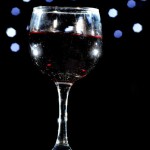- Holly jolly: Parris Benight holds a cava cocktail (recipe in sidebar). Photos by Bill Rhodes
- Tis the season: Reds are perfect wines for the holidays.
The holiday season is a celebratory time of year, full of friends and family — many of them getting all kinds of snookered on liquid cheer. And, although it’s hopelessly heavy, eggnog certainly has its place. But we think wine — red, white or rosé — is the best way to celebrate with a little bit of class (and, with a little know-how, not too much money).
Stocking plenty of wine also means getting to skip the mixers, ice cubes and swizzle sticks, but the oceans of lousy or overpriced wine can be vast and daunting. Although choosing wine sometimes feels intimidating, it really doesn't have to be. Many people still get flummoxed when it's their responsibility to supply the fete with the liquid refreshments, says Matt Logan, the owner of 5 Walnut Wine Bar. "It can be such a nerve-wracking experience for so many people; they're so worried about what's good or not." Puzzled over what wine to serve with your holiday meals? Wonder what pumpkin pie spice or cranberries will do to your palate? Fortunately, we have Parris Benight, the wine director and manager of 5 Walnut, to guide us.
Hubba, hubba, bubble
Want a no-fail festive drink for any occasion? Just pop open the bubbly, says Benight. See how easy that was?
"People always think that Champagne is only for New Year's Eve, and I want to get people out of that mindset," she says. "You can drink sparkling wine any time." We trust that you’ll absorb that information responsibly.
And, by the way, just because it doesn't say Champagne on the label doesn't mean it's not good. But in this economy, you probably already know that. While Champagne comes from a specific area in France located about 100 miles from Paris, "You get great sparkling wine from all over," says Benight.
"You have cava from Spain, there's prosecco, which comes from Italy, and that tends to be in the more off-dry style — not necessarily sweet, but a little bit fruitier,” she says. “Whereas cava tends to be a little bit more tart." Champagne and other sparkling wines from France, as well as sparklers from California, tend to be on the yeasty side, she says.
And while it's often hard to find inexpensive true Champagne, that's not the case with prosecco and cava. "You can find great replacements," says Benight. At 5 Walnut, she pours Saint-Hilaire sparkling wines, an excellent value for the quality, she says. Saint-Hilaire comes from the Limoux region of France, which actually began producing sparkling wine more than a century before Champagne got into the game. "They coined it; they started making it in the methode tradicionale, the same method as Champagne; Champagne just did a better marketing job," says Benight. "But Limoux is the original sparkling wine region. That works great for us because we get the bottle for a quarter of the price of Champagne." Saint-Hilaire wines can be also be found at the Appalachian Vintner in south Asheville, at Bouchon restaurant in downtown Asheville, among other places — just ask your local wine shop.
A rosé by any other name
The name-calling has got to stop, people. Rosé has suffered unfairly from false stereotypes for far too long; not all rosé, for example, tastes like white zinfandel.
"Yep, that's what ruined it,” says Benight. “Fortunately, especially over the past few years, rosé has started to become more up-and-coming, especially among people who drink wine." The trick, she says, is just to get people to taste it. "Once people try it, they're hooked. It can be very dry, it can be fruity, or you can go with the earthier French styles of rosé."
It would be a shame to pass on the pink. Rosé is a highly versatile wine that can be paired with anything from fish to fowl. "It's light enough to go with the turkey, but it could stand up to something that has a little more flavor, like ham," says Benight. "You can go with different regions; the Spanish rosés are going to have a little bit of spice to them, which is good for all of the seasonings that go with holiday foods. French rosés tend to be a little bit more earthy if you're doing things like collard greens or sautéed mushrooms with garlic."
Benight recommends the Adelsheim pinot noir rosé from Willamette Valley, a wine that 5 Walnut sometimes sells by the glass. "It is fantastic. I have turned on so many people that think they don't like rosé and say they don't want to try it. I tell them to take a little sip because it's so earthy — it has that kind of dirty strawberry flavor to it. It's very dry and very nice."
Benight is also a huge fan of sparkling rosé. Real men aren't afraid of pink bubbles, folks. "Anyone can drink it," she says. "It's very sexy and it's fun. It's great for New Year's Eve — there's no better way to kick off the new year than with a glass of brut sparkling rosé."
Winter whites
Think the days of white wine end when the mercury starts to dip? Think again. White wine doesn't have to be a summer porch drink. Gewürztraminer, for example, is rich and bold and goes well with holiday foods, says Benight. "It has nice spice and fruit — it's a good winter white."
Godello is also a good choice, she says. "It's almost like the Spanish chardonnay. It has that really rich flavor and tends to be oak-aged like chardonnay, so you get the spice, you get the vanilla, you get the oakiness and richness.”
And viogniers, she says, are "delightful. They're huge and floral. You don't really need food with them; they're perfect by themselves."
The key to all whites, she says, is not to over-chill them. "Americans tend to enjoy their wines too cold, where you can't really taste the flavors. If you let these wines warm up a little bit, 45 to 50 degrees, you get the full effect of the wine. You get all of the different flavors, and you're not freezing cold, drinking freezing cold wine, in freezing cold weather."
Rockin' reds
On to reds — ‘tis the season, after all. "You can start with lighter and go to heavy, but reds are perfect wines for the holidays," Benight says.
Pinot noir, she says, has become the turkey standby. "And as it should be. It's got the bright fruit flavors, nice acidity, slight spice and real earthiness, depending on what regions you go to." South American pinot noir shows spice, she says. Burgundian pinot noirs and those from Oregon display earthy characteristics.
"But if you want to get away from pinot noir, try Gamay," she says. "It's also light-bodied, has a nice acidity and bright fruit, but it has more of the baking spices — the clove, the nutmeg, the cinnamon."
And don't forget that it's Beaujolais season, she says. "When I talk Beaujolais, I'm not talking Beaujolais nouveau," says Benight. "That's meant to be [consumed] six months after bottling and there' not really a whole lot to it. But true Beaujolais — there's 10 crus in Beaujolais that produce delicious Gamays that are age-worthy and have all the qualities of a good pinot noir. It's just a different grape with something different to offer."
Benight also recommends zweigelt, an Austrian grape with similar characteristics. "Who's drinking zweigelt? You've got to be talking to some people that are into wine to tell you this is a delicious grape,” she says. “We pour it by the glass and people love it."
But, no matter what, there's one rule to remember, says Benight: "You can drink whatever wine you want, whatever season you want, as long as you enjoy it."
— Send your food news to food@mountainx.com






Before you comment
The comments section is here to provide a platform for civil dialogue on the issues we face together as a local community. Xpress is committed to offering this platform for all voices, but when the tone of the discussion gets nasty or strays off topic, we believe many people choose not to participate. Xpress editors are determined to moderate comments to ensure a constructive interchange is maintained. All comments judged not to be in keeping with the spirit of civil discourse will be removed and repeat violators will be banned. See here for our terms of service. Thank you for being part of this effort to promote respectful discussion.